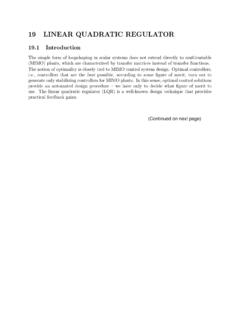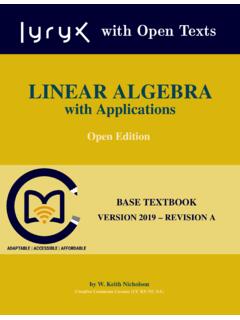Lecture 3 Linear Equations And Matrices
Found 7 free book(s)Lecture 16: Projection matrices and least squares
ocw.mit.eduWe solve these to find Dˆ = 1/2 and Cˆ = 2/3. We could also have used calculus to find the minimum of the following function of two variables: e2 1 + e 2 2 + e 3 2 = (C + D − 1)2 +(C + 2D − 2)2 +(C + 3D − 2)2. Either way, we end up solving a system of linear equations to find that the closest line to our points is b = 2 3 + 1 2 t ...
Introduction to Mathematical Modeling
www.carroll.eduJan 08, 2018 · Chapter 0 To the Student and the Instructor This document contains lecture notes, classroom activities, examples, and challenge prob-lems specifically designed for a first semester of differential equations and linear algebra
CHAPTER 8: MATRICES and DETERMINANTS
kkuniyuk.comSECTION 8.1: MATRICES and SYSTEMS OF EQUATIONS PART A: MATRICES A matrix is basically an organized box (or “array”) of numbers (or other expressions). In this chapter, we will typically assume that our matrices contain only numbers. Example Here is a matrix of size 2 3 (“2 by 3”), because it has 2 rows and 3 columns: 10 2 015
CS229 Lecture notes - Stanford Engineering Everywhere
see.stanford.eduwe decide to approximate y as a linear function of x: hθ(x) = θ0 +θ1x1 +θ2x2 Here, the θi’s are the parameters (also called weights) parameterizing the space of linear functions mapping from X to Y. When there is no risk of confusion, we will drop the θ …
19 LINEAR QUADRATIC REGULATOR - MIT OpenCourseWare
ocw.mit.eduabove equations. 19.4 Gradient Method Solution for the General Case Numerical solutions to the general problem are iterative, and the simplest approach is the gradient method. It is outlined as follows: 1. For a given xo, pick a control history u(t). 2. Propogate x˙ = f(x, u, t) forward in time to create a state trajectory. 3.
CISE 302 Linear Control Systems Laboratory Manual
www.kfupm.edu.sa>> x(3) ans = 1.5708 Í 1st to 3 rd elements of vector x The colon notation may be used to address a block of elements. (start : increment : end) start is the starting index, increment is the amount to add to each successive index, and end is the ending index. A shortened format (start : end) may be used if increment is 1. Example: >> x(1:3) ans =
Linear Algebra With Applications
math.emory.eduAt Calgary, we cover Sections 1.1–1.3, 2.1–2.6, 3.1–3.3, and 4.1–4.4 and the course is taken by all science and engineering students in their first semester. Prerequisites include a …






